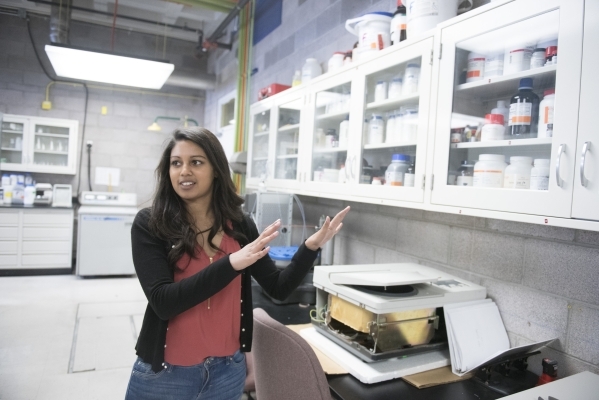UNLV researchers open a new front in HIV battle

A collection of biological codes sits in a library at UNLV. Much of the focus is learning how the codes can help cells fight off HIV. Researchers hope this work can be used to develop drugs much faster.
A library of biological codes sits inside the Schiller Lab of Applied Bioinformatics in UNLV’s Juanita Greer White Life Sciences building.
Like any special collection, this is a place where research takes place.
And like any scientist looking for a discovery, University of Nevada, Las Vegas students and teachers want their work to be known.
They call these codes minimotifs. In laymen’s terms, they’re a chain of directions that tell a cell what to do. And each one directs a different function.
Some have the potential to defend the body from several other diseases by competing with them. All of them help map out the workings inside a cell. At UNLV, much of the focus is learning how the codes can help cells fight off HIV. Researchers hope the work can be used to develop drugs much faster.
One of those researchers is biology major Kiran Mathew. After she completes her chimeric minimotif decoy research project, she said in a recent interview, the library will be ready for replication and distribution.
Every code has a different effect depending on the type of cell or disease it’s applied to, Mathew said. In the case of HIV, the sequence blocks the virus from interacting with the cell, preventing infection.
“We chose HIV as our model system because we know viruses depend solely on cells to live,” she said. “It’s a great model system we can use to test out the effects of (the codes) in the cell.”
More than 1.2 million Americans are infected by the human immunodeficiency virus, or HIV, which causes AIDS. The FDA has approved more than 25 antiretroviral drugs to help patients in multiple ways. Some can fight infections, and others improve one’s overall quality of life.
The local research could facilitate the creation of many more medications, Mathew said.
“Our ultimate goal … would be publication and then patenting this technology because it is novel,” she said. “Nobody is really using this element of biology to gain so much information at once.”
With help from UNLV faculty in residence Christy Strong and a team of undergraduates and mentorship from Martin Schiller, executive director of the Nevada Institute of Personalized Medicine at UNLV’s School of Life Sciences, Mathew synthesized several combinations of genetic codes to create the collection.
The project has yielded promising results, Schiller said, earning a $425,000 grant from the National Institutes of Health. That brings the approximate total of project funding to $600,000.
Schiller submitted the project for a patent a year ago. The U.S. Patent and Trademark Office could take from two to five years to make a decision, he said.
But Schiller is confident that they will receive the license.
“I don’t see how we won’t get one because nobody’s got anything even close to this,” he said.
He said that the research can be used in three ways once the results are published.
The first is drug development. The second would be to apply the codes to a variety of other diseases and understand how the affected cells work. Lastly, he said, would be to create personalized drugs for people by figuring out their own genetic codes.
Mathew said she only needs to run “one or two more” experiments to complete her three-year project. Once published and patented, Schiller said, transitioning the results to a company will be easy.
“The technology would be in a state where the commercial people who came in wouldn’t be looking to advance the science, but how to package it, what the marketing strategy is, distribution and stuff like that,” she said.
Mathew believes her hard work has paid off and sees a bright future for the project.
“It’s really great, and I think it’s definitely gonna revolutionize … the medical field,” she said.
Contact May Ortega at mortega@reviewjournal.com or 702-387-2908. Follow @MayVOrtega on Twitter.